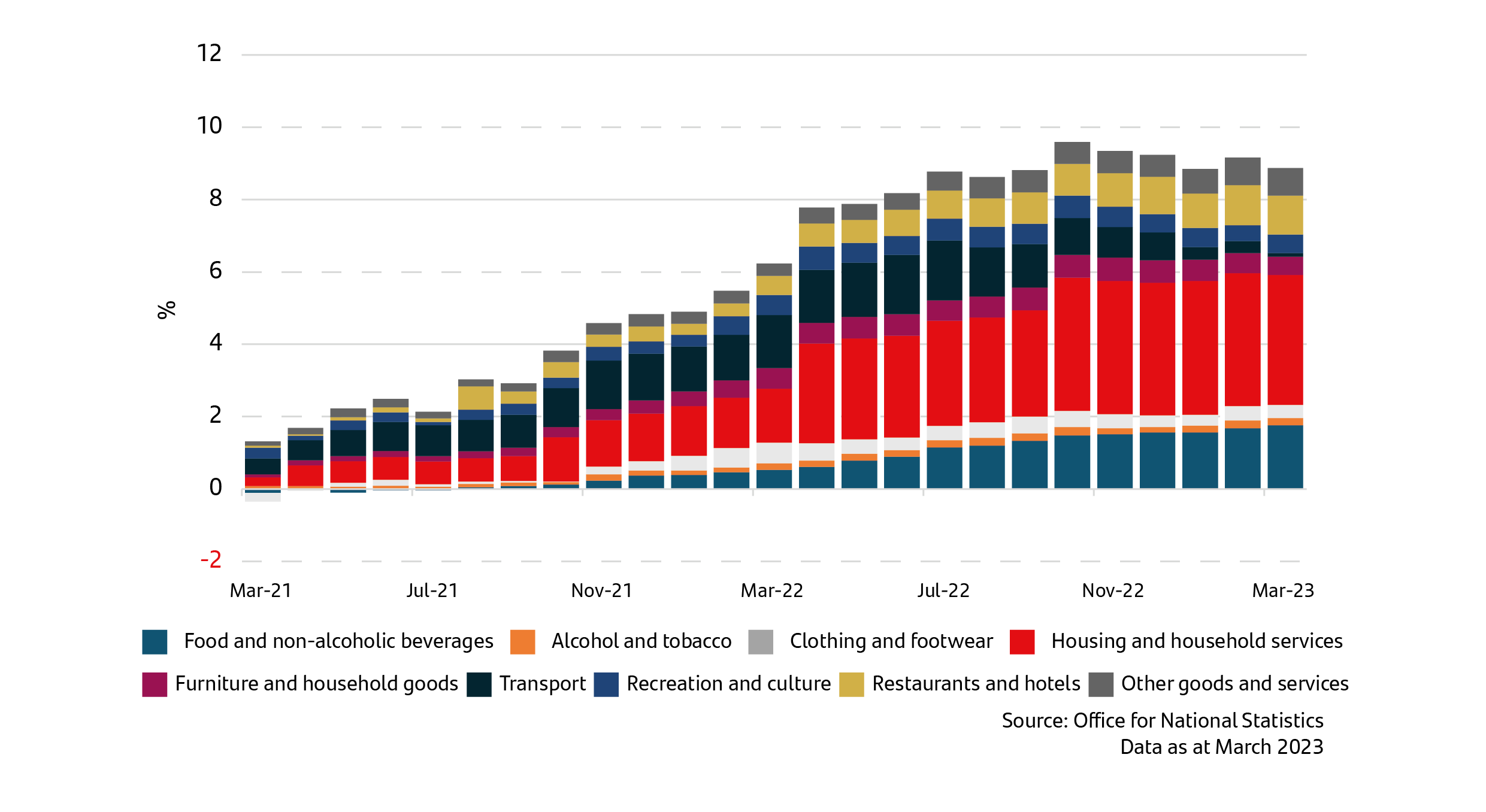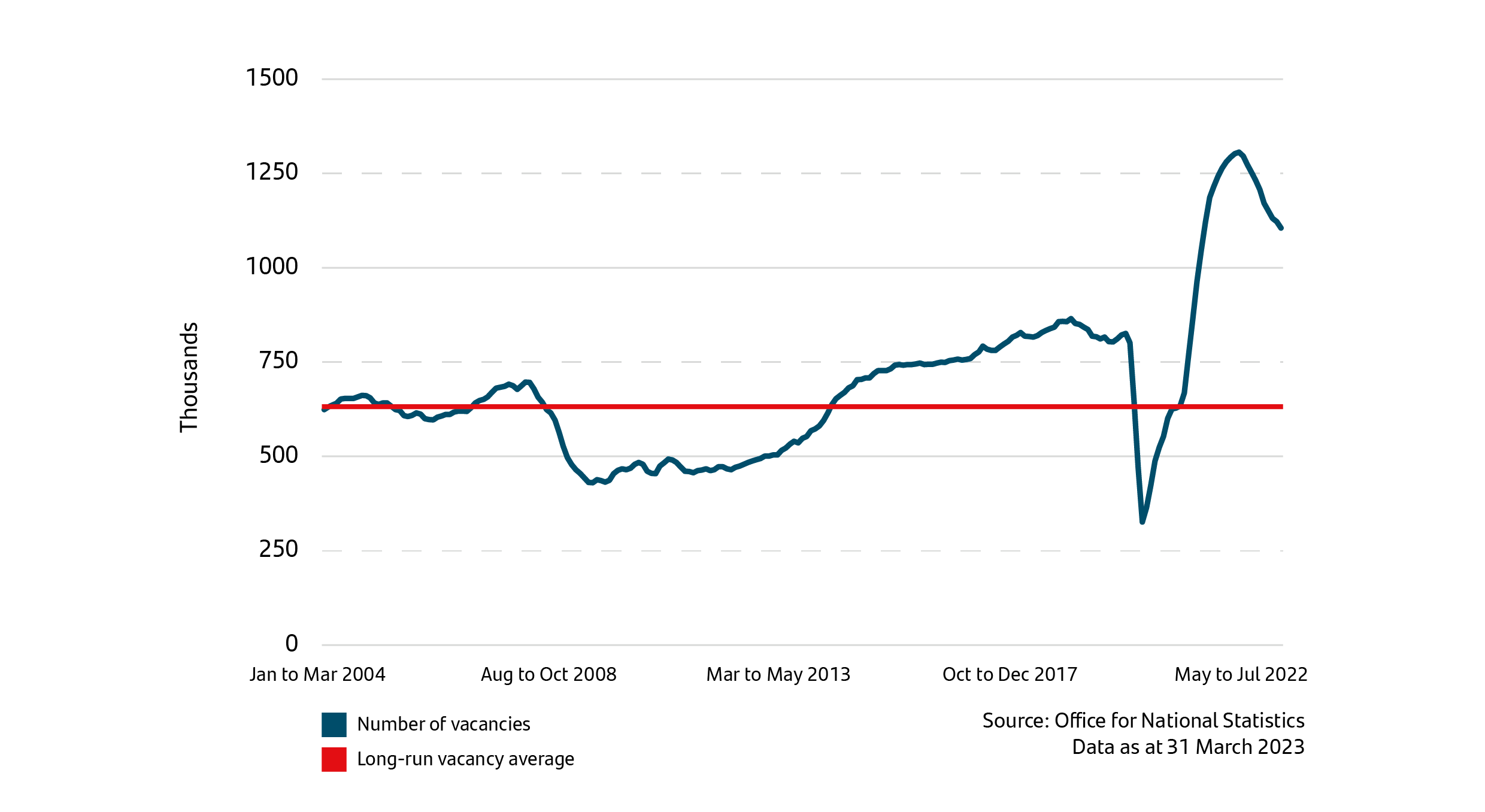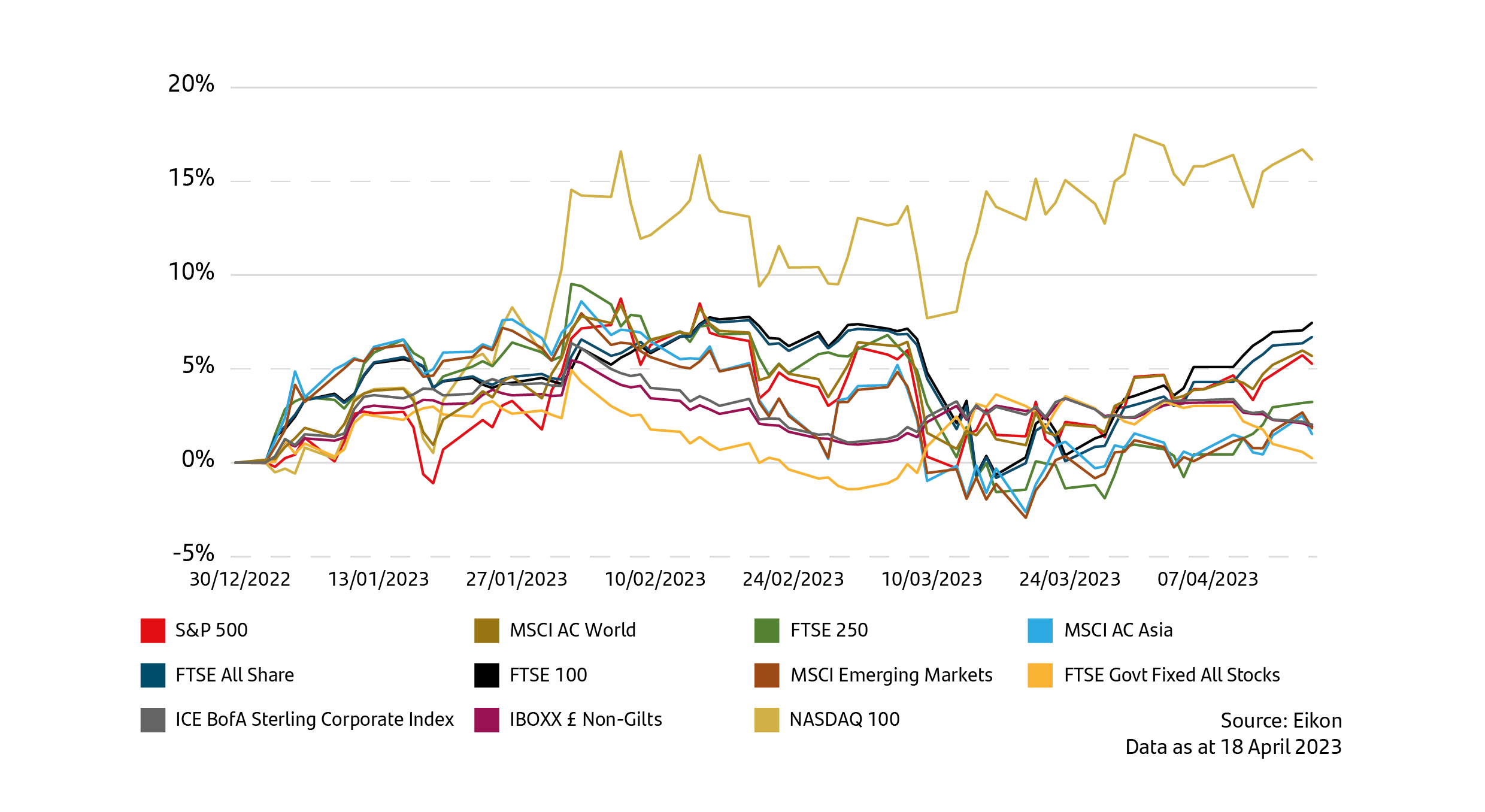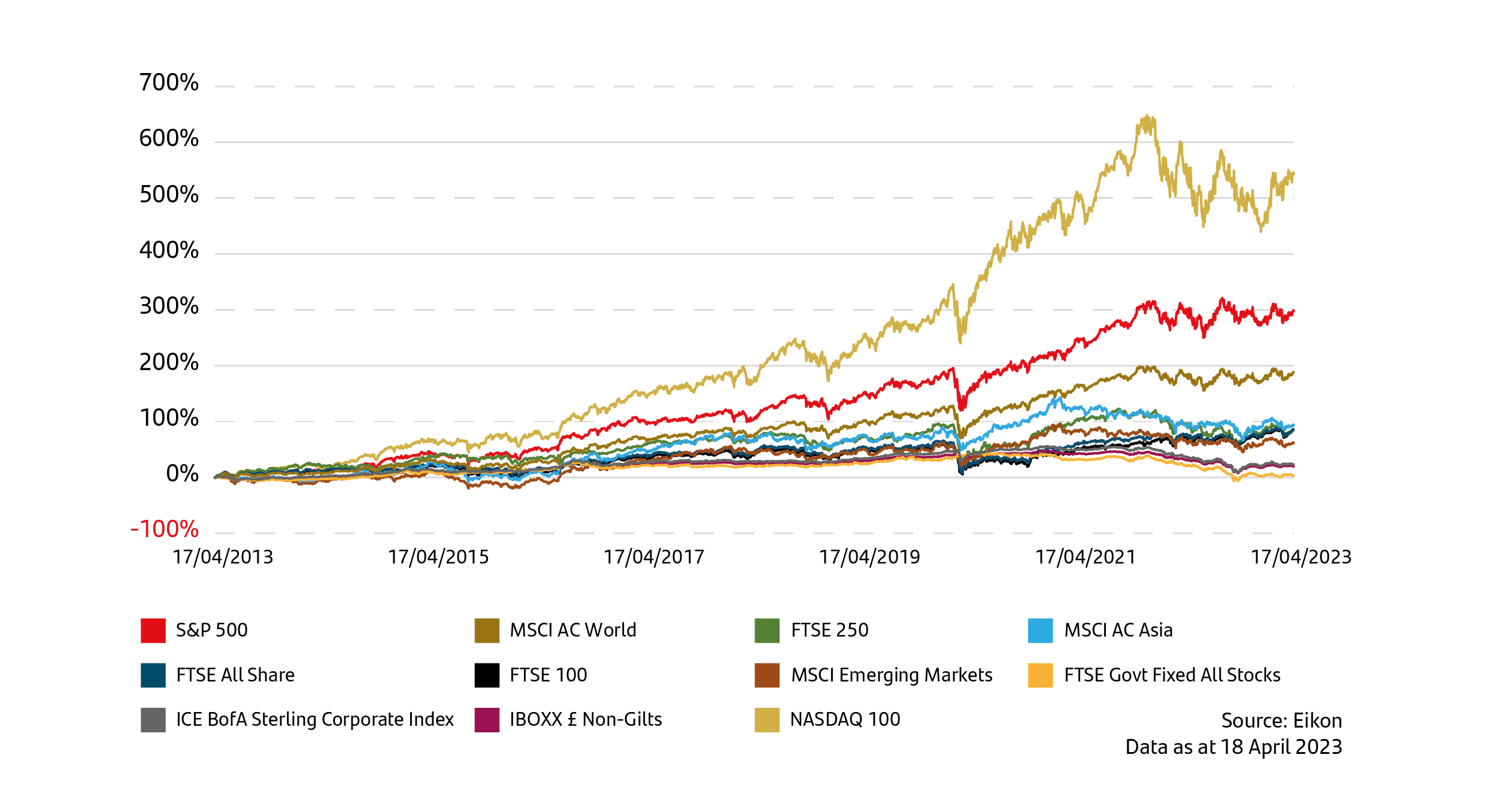As our financial world continues to evolve, price stability and maintaining conditions that help promote steady economic growth remain the benchmark for most central banks. The Bank of England, in pursuit of this goal, faces a difficult diagnosis at their next meeting to decide interest rates on 11 May. Balancing their desire to tame price rises, maintain confidence in the financial system and avoid pushing the economy into a deep recession, makes their decision finely balanced. Our Senior Investment Specialist, Simon Durling, shares his thoughts in this week’s State of Play.
Key highlights from this week’s State of Play
- UK and European inflation update
- UK jobs market cools, but slowly
- Market update
- Investment perspectives reminder
UK and Eurozone inflation latest
UK inflation remains in double digits following the latest data released from the Office for National Statistics. The latest Consumer Price Index fell to 10.1% in the twelve months to March from 10.4% the previous month.1 Grant Fitzner, chief economist at the ONS, explained the key changes this month: ‘The main drivers of the decline in inflation were motor fuel prices and heating oil costs, both of which fell after sharp rises at the same time last year. Clothing, furniture, and household goods prices increased, but more slowly than a year ago. However, these were partially offset by the cost of food, which is still climbing steeply, with bread and cereal price inflation at a record high.’1
Petrol prices fell by 5.9% in the year to March 2023, compared with a rise of 4.6% in February. Average petrol and diesel prices stood at 146.8 and 166.5 pence per litre, respectively, in March 2023, compared with 160.2 and 170.5 pence per litre in March 2022.1 Petrol prices fell by 1.2 pence per litre between February and March 2023, compared with a rise of 12.6 pence per litre between the same two months a year ago after Russia invaded Ukraine in February 2022. Similarly, diesel prices fell by 3.0 pence per litre this year, compared with a rise of 18.8 pence per litre a year ago.1
In Europe, future rate rises look more likely despite inflation dropping by a record amount. Consumer prices in the euro zone rose by 6.9% in the12 months to March following on from an 8.5% increase in February, the biggest drop since Eurostat started collecting data in 1991. The concern for the ECB will be how stubborn core inflation still is. This measure excludes energy and food prices and accelerated to a new all-time high of 7.5% in the 12 months to March, from 7.4% in February.2
Contributions to the annual CPIH inflation rate, UK, March 2021 to March 2023

UK earnings and employment update
Over the last few months, the Bank of England has continued to raise interest rates, trying to tame rising prices. One aspect they continue to cite as a reason to be cautious about pausing rate hikes too early is their concern about the UK job market. The latest data from the Office for National Statistics (ONS) showed that the pressure has eased, but probably not enough for the MPC members to finally breathe a sigh of relief. The UK employment market has been described as tight, which, put simply, means there are not enough applicants to fill the high number of vacancies, forcing employers to compete to attract new recruits. This leads to employers offering better salary packages to secure the right candidate. The worry for the bank is that this competition for talent leads to higher wages, feeding into more consumer demand and pushing up prices, making it more difficult to bring inflation back down to the long-term target of 2%.
According to the ONS, although unemployment rose slightly in the three months to February from 3.7% to 3.8%, the number of vacancies only fell by 47,000 between January and March to leave it well above the million mark at 1,105,000.3 This was the ninth month in a row that vacancies fell, albeit the descent from the record highs has been painfully slow for the bank to observe and remains twice the long-run average over the last 20 years, hence their continuing caution (please see chart below). Although tightness in the labour market has eased slightly, the banks concerns are justified as wage growth remains stubbornly high.
Job vacancies for January to March 2023

The ONS report states: ‘Growth in average total pay (including bonuses) was 5.9% and growth in regular pay (excluding bonuses) was 6.6% among employees in December 2022 to February 2023. Average regular pay growth for the private sector was 6.9% in December 2022 to February 2023 and 5.3% for the public sector. The difference between the private and public sector growth rates has narrowed in recent months.’ They continue to explain the impact on real wages when accounting for the cost-of-living crisis, ‘In real terms (adjusted for inflation), growth in total and regular pay fell on the year in December 2022 to February 2023, by 3.0% for total pay and by 2.3% for regular pay. A larger fall on the year for real total pay was last seen in February to April 2009, when it fell by 4.5%, but it still remains among the largest falls in growth since comparable records began in 2001’.
One anomaly for the UK versus other developed economies has been the number of inactive workers when compared to before the pandemic. In previous updates, State of Play has explored the potential reasons for this, with many in their 50’s and 60’s having to isolate during lockdowns, highlighting that they didn’t need to return to work when the economy reopened. The most recent government budget tried to tackle this with various measures designed to lure older workers back into work. The numbers were also affected by a significant increase in long-term sick and more students choosing education over starting work. In the latest quarter, as measured from December 2022 to February this year, the inactivity rate decreased by 0.4% to 21.1%, mainly driven by people aged between 16 and 24 years.
Market update
April thus far (as of the time of writing) has seen markets grind higher, albeit slowly. Nerves remain about the next round of rate rises and this reflects in both share price volatility and bond yields, which have seen increases in recent weeks. UK 10-year gilts have risen 0.5% since 24 March to reach nearly 3.8% at the time of writing.4 Wage rises, vacancy numbers and stubbornly low unemployment, whilst celebrated in normal economic cycles, provide a headache for the bank rate setters, and make it more likely that we will see a further rate rise on 11 May. The latest economic data for China beat market forecasts as their economy bounced back following the end of the zero-COVID restrictions, which led to last year’s Gross Domestic Product (GDP) growth being the second worst in nearly 50 years at only 3%.5
Despite the banking crisis in mid-March following the collapse of Silicon Valley Bank (SVB), the most recent round of banks reporting earnings has shown that while their share prices sold-off sharply at the time, the larger US banks benefited from an influx of cash from worried depositors, where customers of smaller regional banks moved large quantities of cash to their bigger peers. Many banks have benefited from increasing interest rates, which have helped grow their earnings in the process. In addition, some of the larger asset managers also saw cash flood in as depositors sought safe havens in cash funds rather than banks.6
Investment perspective – remember to think decade, not days
One aspect of my working week is monitoring market sentiment and investment returns across various asset classes and geographies. This involves observing trends and differences between one asset class and another or one region when compared to others. At times, the charts can look like something from an impressionist painting, which highlights why retail investors can sometimes get overwhelmed by the short-term news driving changes in their investment portfolio values. The chart below shows various asset classes and regions since the start of this year. At first glance, it is understandable why so many panic and may suffer from investor’s remorse before heading for the exit. The actual results show strong positive investment returns across the board, but they were delivered via a rollercoaster ride.
Year to date performance
 However, when fear dominates our emotions, humans are hard-wired to act, often to their financial detriment. Making investment choices for most of us involves building a plan to address short-term, medium-term, and long-term aspirations. Investing typically falls into the long-term pot. The reason why investing is recommended over such timescales is to allow for short term volatility in an to attempt to meet longer-term financial goals. The chart below best illustrates why zooming out to see the longer-term picture should provide retail investors more comfort and confidence to stick to the plan. Clearly, past performance is not a guide to future investment returns, but it at least shows the journey is much smoother than it feels, especially given the dramatic backdrop we have lived through in the last three years. In my experience, investors are normally rewarded for their patience, provided they have an appropriately diversified portfolio in place aligned to their risk comfort, time horizons and financial goals.
However, when fear dominates our emotions, humans are hard-wired to act, often to their financial detriment. Making investment choices for most of us involves building a plan to address short-term, medium-term, and long-term aspirations. Investing typically falls into the long-term pot. The reason why investing is recommended over such timescales is to allow for short term volatility in an to attempt to meet longer-term financial goals. The chart below best illustrates why zooming out to see the longer-term picture should provide retail investors more comfort and confidence to stick to the plan. Clearly, past performance is not a guide to future investment returns, but it at least shows the journey is much smoother than it feels, especially given the dramatic backdrop we have lived through in the last three years. In my experience, investors are normally rewarded for their patience, provided they have an appropriately diversified portfolio in place aligned to their risk comfort, time horizons and financial goals.
10 Year performance

The value of seeking guidance and advice
It is important to seek advice and guidance from a professional financial adviser who can help to explain how to build an appropriate financial plan to match your time horizons, financial ambitions, and risk comfort. If you already have a plan in place, or have already invested, it is important to allocate time to review this to ensure this remains on track and appropriate for your needs.

Investing can feel complex and overwhelming, but our educational insights can help you cut through the noise. Learn more about the Principles of Investing here.
Note: 1Office for National Statistics (ONS), 18 April 2023. 2Reuters, 31 March 2023. 3Office for National Statistics (ONS), 19 April 2023. 4Investing.com, 19 April 2023. 5Times Newspaper,15 April 2023. 6Financial Times, 14 April 2023.
Important information
For retail distribution. This document has been approved and issued by Santander Asset Management UK Limited (SAM UK). This document is for information purposes only and does not constitute an offer or solicitation to buy or sell any securities or other financial instruments, or to provide investment advice or services. Opinions expressed within this document, if any, are current opinions as of the date stated and do not constitute investment or any other advice; the views are subject to change and do not necessarily reflect the views of Santander Asset Management as a whole or any part thereof. While we try and take every care over the information in this document, we cannot accept any responsibility for mistakes and missing information that may be presented.
All information is sourced, issued and approved by Santander Asset Management UK Limited (Company Registration No. SC106669). Registered in Scotland at 287 St Vincent Street, Glasgow G2 5NB, United Kingdom. Authorised and regulated by the FCA. FCA registered number 122491. You can check this on the Financial Services Register by visiting the FCA’s website www.fca.org.uk/register




